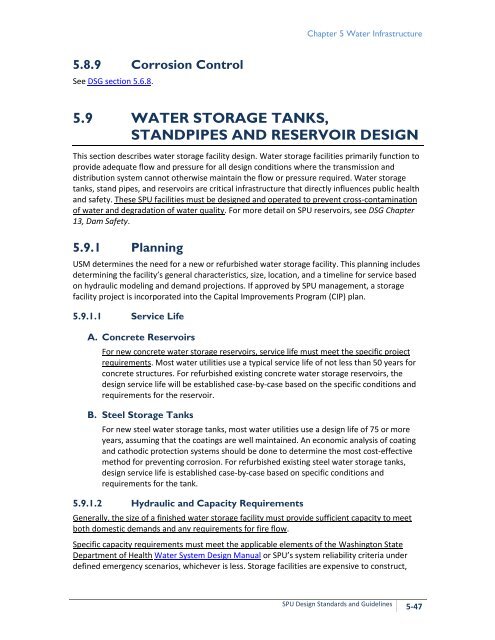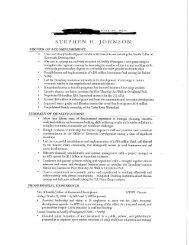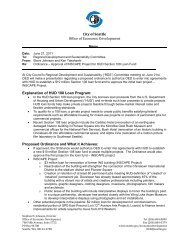2013 Water System Plan, Volume II - Seattle City Clerk's Office - City ...
2013 Water System Plan, Volume II - Seattle City Clerk's Office - City ...
2013 Water System Plan, Volume II - Seattle City Clerk's Office - City ...
You also want an ePaper? Increase the reach of your titles
YUMPU automatically turns print PDFs into web optimized ePapers that Google loves.
Chapter 5 <strong>Water</strong> Infrastructure<br />
5.8.9 Corrosion Control<br />
See DSG section 5.6.8.<br />
5.9 WATER STORAGE TANKS,<br />
STANDPIPES AND RESERVOIR DESIGN<br />
This section describes water storage facility design. <strong>Water</strong> storage facilities primarily function to<br />
provide adequate flow and pressure for all design conditions where the transmission and<br />
distribution system cannot otherwise maintain the flow or pressure required. <strong>Water</strong> storage<br />
tanks, stand pipes, and reservoirs are critical infrastructure that directly influences public health<br />
and safety. These SPU facilities must be designed and operated to prevent cross-contamination<br />
of water and degradation of water quality. For more detail on SPU reservoirs, see DSG Chapter<br />
13, Dam Safety.<br />
5.9.1 <strong>Plan</strong>ning<br />
USM determines the need for a new or refurbished water storage facility. This planning includes<br />
determining the facility’s general characteristics, size, location, and a timeline for service based<br />
on hydraulic modeling and demand projections. If approved by SPU management, a storage<br />
facility project is incorporated into the Capital Improvements Program (CIP) plan.<br />
5.9.1.1 Service Life<br />
A. Concrete Reservoirs<br />
For new concrete water storage reservoirs, service life must meet the specific project<br />
requirements. Most water utilities use a typical service life of not less than 50 years for<br />
concrete structures. For refurbished existing concrete water storage reservoirs, the<br />
design service life will be established case-by-case based on the specific conditions and<br />
requirements for the reservoir.<br />
B. Steel Storage Tanks<br />
For new steel water storage tanks, most water utilities use a design life of 75 or more<br />
years, assuming that the coatings are well maintained. An economic analysis of coating<br />
and cathodic protection systems should be done to determine the most cost-effective<br />
method for preventing corrosion. For refurbished existing steel water storage tanks,<br />
design service life is established case-by-case based on specific conditions and<br />
requirements for the tank.<br />
5.9.1.2 Hydraulic and Capacity Requirements<br />
Generally, the size of a finished water storage facility must provide sufficient capacity to meet<br />
both domestic demands and any requirements for fire flow.<br />
Specific capacity requirements must meet the applicable elements of the Washington State<br />
Department of Health <strong>Water</strong> <strong>System</strong> Design Manual or SPU’s system reliability criteria under<br />
defined emergency scenarios, whichever is less. Storage facilities are expensive to construct,<br />
SPU Design Standards and Guidelines<br />
5-47
















